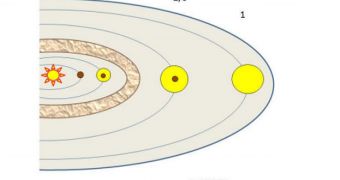For decades, astronomers have had problems with explaining the very structure of the solar system, as in figuring out why is it that planets and asteroid belts within are arranged the way they are. A new theory now explains the structure of the solar neighborhood with great elegance.
When looking at our solar system from afar, the first thing that becomes apparent are its main elements and structure – four rocky planets orbiting the Sun in its inner segment, then four gas giants spinning around the star at the edge of the system.
The two planetary groups are separated from each other by the Inner Asteroid Belt (IAB), while the gas giants are separated from Pluto-class dwarf planets by the Kuiper Belt. Further outwards, the Oort Cloud marks the end of the system.
But the issue with this organized, compartmentalized setup is that existing theories on how planets form cannot readily explain it, Technology Review reports.
The main model the international astronomical community has been sticking to for the last four decades holds that planetesimals, the precursors of fully-fledged planets, develop first.
This happens inside a young star's accretion disk. Tiny particles of rock and dust slowly begin to come together, forming condensation nuclei on which even more particles adhere. Once the protoplanet is formed, the gases that make up the atmosphere are attracted to the bodies.
According to this theory, gas giants develop from cores at least ten times more massive than our entire planet, which become capable of attracting and keeping vast gas envelopes around them.
But this model has several key problems, which more and more astronomers have began discussing over the past few months. Now, A UK-based researcher presents the new line of thought in a clean and straightforward manner.
University of Leicester expert Sergei Nayakshin turns the old model on its head with the new proposal. He argues that planets begin developing some 50 astronomical units (AU) away from their stars.
An AU is the distance between Earth and the Sun. At 50 away, planets would start to develop from random variations in the density of the protoplanetary gas, which would contribute to attracting even more gas to those areas.
The force of gravity would then create loose lumps called giant planet embryos, at the center of which all rocky material would come together to form rocky cores.
As this process is taking place, the embryonic planets are also influenced by the gas clouds of the parent star. Nayakshin proposes that this interactions are what drew the planets closer to their star.
When the gas planets get too close, tidal forces and irradiation from the Sun forces their gas envelopes to dissipate, leaving behind only the rocky cores.
At a certain distance from the star, the planets traveling too much inwards (Mercury, Venus, Earth and Mars) also shed any rocks they may have carried in the upper atmosphere.
This distance, which was calculated in the new study, corresponds to where the IAB is now located. This is the first time experts managed to come up with an explanation of why the Belt exists, and why it separates two entirely distinct sets of planets.

 14 DAY TRIAL //
14 DAY TRIAL //